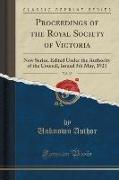- Start
- Proceedings of the Royal Society of Victoria, Vol. 33
Proceedings of the Royal Society of Victoria, Vol. 33
Angebote / Angebote:
Excerpt from Proceedings of the Royal Society of Victoria, Vol. 33: New Series, Edited Under the Authority of the Council, Issued 9th May, 1921
The material on which this paper is founded is derived from several sources: A number of the new species are from a collection of Tabanidae forwarded to me from the National Museum, Melbourne, for identification, others are from Mr. Hardy's collection, mainly Tasmanian, but including a few Western Australian forms, the remainder are from the collection of the Department of Public Health, New South Wales.
It was hoped when the paper was undertaken to have revised the whole of the species comprised in the hairy-eyed group of Tabanus, but the completion of this work would probably delay this paper unnecessarily, and it seems better that the descriptions of the new species should be published as soon as possible.
Most of the material under study being from the Southern portion of Australia, types that I regard as of Antarctic origin predominate. To my mind our Australian Tabanid fauna has been derived from two sources - (1) Malayan, from which come species belonging to Corizoneura, Silvius and Tabanus (excluding the hairy-eyed group), (2) Antarctic, from which source have probably been derived our Southern Tabanid fauna, including the genera Diatomineura, Erephopsis, Pelecorrhynchus and the hairy-eyed group of Tabanus (Therioplectes).
The distinction between Diatomineura and Erephopsis is by no means constant, the two genera are merely separated on the point of distinction involved in the opening or closure of the first posterior cell. In many species of Erephopsis in which the cell is usually closed examples are readily found in which it is open. On the other hand this cell may be closed in individuals belonging to many species of Diatomineura, in which the cell is habitually open.
I am indebted to Miss Phyllis F. Clarke for the illustrations that accompany this paper.
About the Publisher
Forgotten Books publishes hundreds of thousands of rare and classic books. Find more at www.forgottenbooks.com
This book is a reproduction of an important historical work. Forgotten Books uses state-of-the-art technology to digitally reconstruct the work, preserving the original format whilst repairing imperfections present in the aged copy. In rare cases, an imperfection in the original, such as a blemish or missing page, may be replicated in our edition. We do, however, repair the vast majority of imperfections successfully, any imperfections that remain are intentionally left to preserve the state of such historical works.
Folgt in ca. 5 Arbeitstagen


